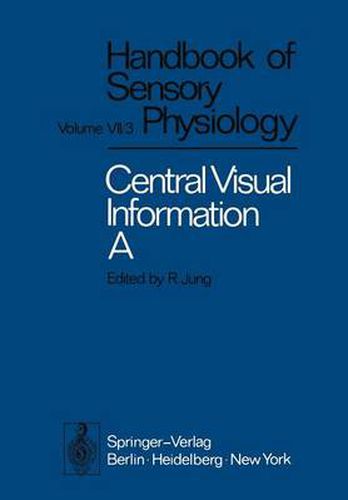Readings Newsletter
Become a Readings Member to make your shopping experience even easier.
Sign in or sign up for free!
You’re not far away from qualifying for FREE standard shipping within Australia
You’ve qualified for FREE standard shipping within Australia
The cart is loading…






This title is printed to order. This book may have been self-published. If so, we cannot guarantee the quality of the content. In the main most books will have gone through the editing process however some may not. We therefore suggest that you be aware of this before ordering this book. If in doubt check either the author or publisher’s details as we are unable to accept any returns unless they are faulty. Please contact us if you have any questions.
The present volume covers the physiology of the visual system beyond the optic nerve. It is a continuation of the two preceding parts on the photochemistry and the physiology of the eye, and forms a bridge from them to the fourth part on visual psychophysics. These fields have all developed as independent speciali ties and need integrating with each other. The processing of visual information in the brain cannot be understood without some knowledge of the preceding mechanisms in the photoreceptor organs. There are two fundamental reasons, ontogenetic and functional, why this is so: 1) the retina of the vertebrate eye has developed from a specialized part of the brain; 2) in processing their data the eyes follow physiological principles similar to the visual brain centres. Peripheral and central functions should also be discussed in context with their final synthesis in subjective experience, i. e. visual perception. Microphysiology and ultramicroscopy have brought new insights into the neuronal basis of vision. These investigations began in the periphery: HARTLINE’S pioneering experiments on single visual elements of Limulus in 1932 started a successful period of neuronal recordings which ascended from the retina to the highest centres in the visual brain. In the last two decades modern electron microscopic techniques and photochemical investigations of single photoreceptors further contributed to vision research.
$9.00 standard shipping within Australia
FREE standard shipping within Australia for orders over $100.00
Express & International shipping calculated at checkout
This title is printed to order. This book may have been self-published. If so, we cannot guarantee the quality of the content. In the main most books will have gone through the editing process however some may not. We therefore suggest that you be aware of this before ordering this book. If in doubt check either the author or publisher’s details as we are unable to accept any returns unless they are faulty. Please contact us if you have any questions.
The present volume covers the physiology of the visual system beyond the optic nerve. It is a continuation of the two preceding parts on the photochemistry and the physiology of the eye, and forms a bridge from them to the fourth part on visual psychophysics. These fields have all developed as independent speciali ties and need integrating with each other. The processing of visual information in the brain cannot be understood without some knowledge of the preceding mechanisms in the photoreceptor organs. There are two fundamental reasons, ontogenetic and functional, why this is so: 1) the retina of the vertebrate eye has developed from a specialized part of the brain; 2) in processing their data the eyes follow physiological principles similar to the visual brain centres. Peripheral and central functions should also be discussed in context with their final synthesis in subjective experience, i. e. visual perception. Microphysiology and ultramicroscopy have brought new insights into the neuronal basis of vision. These investigations began in the periphery: HARTLINE’S pioneering experiments on single visual elements of Limulus in 1932 started a successful period of neuronal recordings which ascended from the retina to the highest centres in the visual brain. In the last two decades modern electron microscopic techniques and photochemical investigations of single photoreceptors further contributed to vision research.